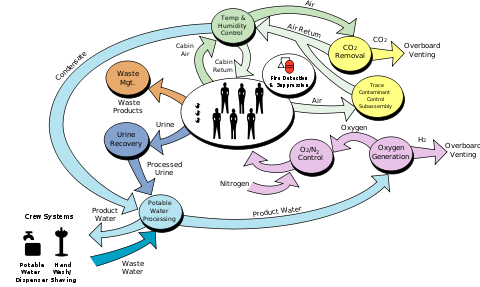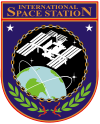- ISS ECLSS
-
The International Space Station Environmental Control and Life Support System (ECLSS) is a life support system that provides or controls atmospheric pressure, fire detection and suppression, oxygen levels, waste management and water supply. The highest priority for the ECLSS is the ISS atmosphere, but the system also collects, processes, and stores waste and water produced and used by the crew—a process that recycles fluid from the sink, shower, toilet, and condensation from the air. The Elektron system aboard Zvezda and a similar system in Destiny generate oxygen aboard the station.[1] The crew has a backup option in the form of bottled oxygen and Solid Fuel Oxygen Generation (SFOG) canisters.[2] Carbon dioxide is removed from the air by the Vozdukh system in Zvezda. Other by-products of human metabolism, such as methane from the intestines and ammonia from sweat, are removed by activated charcoal filters.[2]
Contents
Water recovery systems
The ISS has two water recovery systems. Zvezda contains a water recovery system that processes waste water from showers, sinks, and other crew systems and water vapor from the atmosphere that could be used for drinking in an emergency but is normally fed to the Elektron system to produce oxygen. The American segment has a Water Recovery System installed during STS-126 in Destiny that can process water vapour collected from the atmosphere, waste water from showers, sinks, and other crew systems, and also urine into water that is intended for drinking.
The Water Recovery System consists of a Urine Processor Assembly and a Water Processor Assembly.
The Urine Processor Assembly uses a low pressure vacuum distillation process that uses a centrifuge to compensate for the lack of gravity and thus aid in separating liquids and gasses.
Water from the Urine Processor Assembly and from waste water sources are combined to feed the Water Processor Assembly that filters out gasses and solid materials before passing through filter beds and then a high-temperature catalytic reactor assembly. The water is then tested by onboard sensors and unacceptable water is cycled back through the water processor assembly.
The Volatile Removal Assembly flew on STS-89 in January 1998 to demonstrate the Water Processor Assembly's catalytic reactor in microgravity. A Vapour Compression Distillation Flight Experiment flew, but was destroyed, in STS-107.
The Water Recovery System failed during the first tests and required astronauts to remove several rubber vibration isolators as the way the system was configured when it was first installed caused balance issues with the centrifuge in the vacuum distillation assembly that resulted in it failing with an error code after two hours of use. Six litres of water will be returned with STS-126 to calibrate the on-board analysis and after running successfully for 90 days, the station will be able to support an additional three astronauts.
Atmosphere
Several systems are currently used on board the ISS to maintain the spacecraft's atmosphere, which is similar to the Earth's.[3] Normal air pressure on the ISS is 101.3 kPa (14.7 psi);[4] the same as at sea level on Earth. An Earth-like atmosphere offers benefits for crew comfort, and is much safer than the alternative, a pure oxygen atmosphere, because of the increased risk of a fire such as that responsible for the deaths of the Apollo 1 crew.[5]
Air revitalisation system
Carbon dioxide and trace contaminants are removed by the Air Revitalisation System. This is a NASA rack, to be placed in Tranquillity, designed to provide a Carbon Dioxide Removal Assembly (CDRA), a Trace Contaminant Control Subassembly (TCCS) to remove hazardous trace contamination from the atmosphere and a Major Constituent Analyser (MCA) to monitor Nitrogen, Oxygen, Carbon dioxide, Methane, hydrogen, and water vapour. The Air Revitalization System was flown to the station aboard STS-128 and was temporarily installed in the Japanese Experiment Module Pressurised Module. The system is scheduled to be transferred to Tranquillity now that the module has arrived and was installed during Space Shuttle Endeavour mission STS-130.[6]
Oxygen generating system
The Oxygen Generating System (OGS) is a NASA rack designed to electrolyse water from the Water Recovery System to produce oxygen and hydrogen. The oxygen is delivered to the cabin atmosphere and the hydrogen is vented overboard.[7] The unit is installed in the Destiny module. During one of the spacewalks conducted by STS-117 astronauts, a hydrogen vent valve required to begin using the system was installed. The system became operational on 12 July 2007.[8]
In 2011, American news outlet CBS news and news magazine spaceflightnow reported "The OGA over the past six months has not been running well because the water that's been fed to it is just slightly too acidic," said station Flight Director Chris Edelen. "For the past several months, the station crew has been using oxygen brought up aboard visiting Progress supply ships, a European cargo craft and the Russian Elektron oxygen generator while awaiting delivery of the OGA repair equipment. The OGA, like the Elektron, uses electricity to split water molecules into hydrogen and oxygen. " [9]
Elektron
Elektron is a Russian oxygen generator, also used on Mir, which uses electrolysis to produce oxygen. This process splits water molecules reclaimed from other uses on board the station into oxygen and hydrogen via electrolysis. The oxygen is vented into the cabin and the hydrogen is vented into space. Nasa claims the three Elektron oxygen generators on board the International Space Station have been 'plagued with problems', sometimes forcing the crew to use backup sources of bottled oxygen and Solid Fuel Oxygen Generation (SFOG) canisters. Each canister can supply the oxygen needs of one crewmember for one day. NASA delivered a similar American-built system with Discovery flight STS-121, to supplement the Russian Elektron oxygen system and eventually support a crew of six. It became operational in 2007. [10] This was the first time Americans had reprocessed the atmosphere of any spacecraft. From 2001, the US orbital segment had used oxygen in a pressurized storage tank on the Quest airlock module, or from the Russian service module.
In 2004, the Elektron unit shut down mysteriously[weasel words]. Two weeks of troubleshooting resulted in the unit starting up again, then immediately shutting down. The cause was eventually traced to gas bubbles in the unit, which remained non-functional until a Progress resupply mission in October 2004.[11] In 2005 ISS personnel tapped into the oxygen supply of the recently-arrived Progress resupply ship, when the Elektron unit failed.[12] In 2006 fumes from a malfunctioning Elektron unit prompted NASA flight engineers to declare a "spacecraft emergency". A burning smell led the ISS crew to suspect another Elektron fire, but the unit was only "very hot". A leak of corrosive, odorless potassium hydroxide forced the ISS crew to don gloves and face masks. It has been conjectured that the smell came from overheated rubber seals. The incident occurred shortly after STS-115 left and just before arrival of a resupply mission (including space tourist Anousheh Ansari).[13] The Elektron did not come back online until November 2006, after new valves and cables arrived on the October 2006 Progress resupply vessel.[14] The ERPTC (Electrical Recovery Processing Terminal Current) was inserted into the ISS to prevent harm to the systems.
Vika
A backup to the temperamental Elektron system used on both the ISS and Mir is the Vika solid-fuel oxygen generator (SFOG), which contains a replaceable cartridge, a thin walled steel tube with a three-part block of oxygen-releasing mixture based on lithium perchlorate. Two parts are tablets of the chemical mixture and the third one is the igniter tablet with a flash igniter. The igniter is struck by a firing pin when the device is activated. One cartridge releases 600 litres (160 US gal) of oxygen and burns for 5–20 minutes at 450–500 °C (842–932 °F)[15] The oxygen is cooled and filtered from dust and odours, and released into the space station atmosphere.[citation needed]
On 23 February 1997, during the exchange of an air filter, a failed chemical oxygen generator spewed a torch-like jet of a molten metal and sparks across one of the Mir space station modules, burning for 14 minutes and blocking the escape route to one of the Soyuz spacecraft. The accident was caused by a leak of the lithium perchlorate from one of the canisters.[citation needed]
Vozdukh
Another Russian system, Vozdukh (Russian Воздух, meaning "air"), removes carbon dioxide from the air based on the use of regenerable absorbers of carbon dioxide gas.[16]
References
- ^ Tariq Malik (15 February 2006). "Air Apparent: New Oxygen Systems for the ISS". Space.com. http://www.space.com/businesstechnology/060215_techwed_iss_oxygen.html. Retrieved 21 November 2008.
- ^ a b Patrick L. Barry (13 November 2000). "Breathing Easy on the Space Station". NASA. http://science.nasa.gov/headlines/y2000/ast13nov_1.htm. Retrieved 21 November 2008.
- ^ Craig Freudenrich (20 November 2000). "How Space Stations Work". Howstuffworks. http://science.howstuffworks.com/space-station2.htm. Retrieved 23 November 2008.
- ^ "5–8: The Air Up There". NASAexplores. NASA. Archived from the original on 14 November 2006. http://web.archive.org/web/20061114010931/http://www.nasaexplores.com/show2_5_8a.php?id=04-032&gl=58. Retrieved 31 October 2008.
- ^ Clinton Anderson; et. al. (30 January 1968). Report of the Committee on Aeronautical and Space Sciences, United States Senate—Apollo 204 Accident. Washington, DC: US Government Printing Office. pp. 8. http://klabs.org/richcontent/Reports/Failure_Reports/as-204/senate_956/as204_senate_956.pdf.
- ^ "STS-128 Press Kit" (PDF). NASA. 18 August 2009. http://www.nasa.gov/pdf/379392main_STS-128_Press_Kit.pdf. Retrieved 1 September 2009.
- ^ "International Space Station Environmental Control and Life Support System" (PDF). NASA. http://www.nasa.gov/centers/marshall/pdf/104840main_eclss.pdf. Retrieved 25 January 2010.
- ^ Chris Bergin (12 July 2007). "Oxygen Generating System activated onboard ISS". NASASpaceflight.com. http://www.nasaspaceflight.com/2007/07/oxygen-generating-system-activated-onboard-iss/. Retrieved 25 January 2010.
- ^ http://spaceflightnow.com/shuttle/sts133/110305fd10/index2.html
- ^ "International Space Station Status Report: SS07-01". NASA. 5 January 2007. http://www.nasa.gov/home/hqnews/2007/jan/HQ_SS0701_station_status.html. Retrieved 25 January 2010.
- ^ Amit Asaravala (20 September 2004). "Space O2 Generator Fails Again". Wired News. http://www.wired.com/science/space/news/2004/09/65026. Retrieved 25 January 2010.
- ^ Tariq Malik (4 January 2005). "Repaired Oxygen Generator Fails Again Aboard ISS". Space.com. http://www.space.com/missionlaunches/exp10_elektron_050104.html. Retrieved 25 January 2010.
- ^ William Harwood (18 September 2006). "Oxygen generator problem triggers station alarm". Spaceflight Now. http://www.spaceflightnow.com/station/exp13/060918elektron.html. Retrieved 25 January 2010.
- ^ "International Space Station Status Report #48". NASA. 3 November 2006. http://www.nasa.gov/home/hqnews/2006/nov/HQ_SS06048_station_status.html. Retrieved 25 January 2010.
- ^ Oxygen Generators
- ^ "In-Flight Carbon Dioxide Exposures and Related Symptoms: Association, Susceptibility, and Operational Implications" (see page 6), NASA, June 2010.
Categories:- Components of the International Space Station
- Medical technology
Wikimedia Foundation. 2010.



